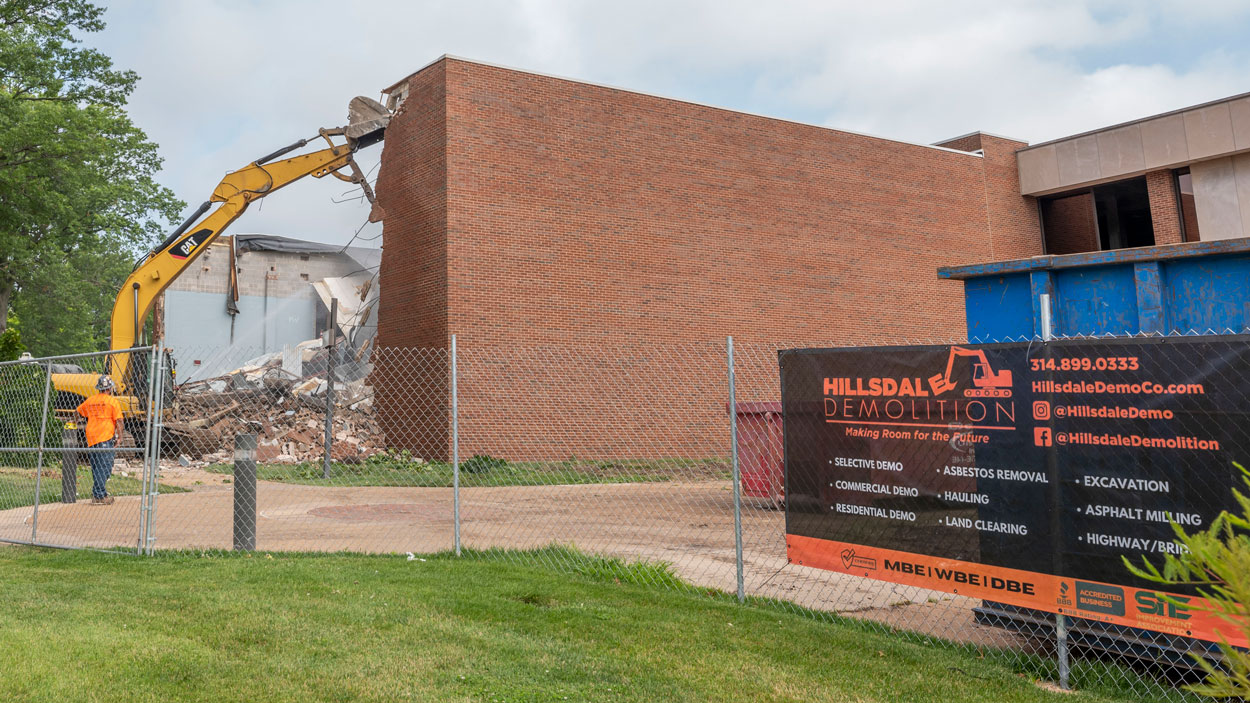
A crew from Hillsdale Demolition tears down the wall to the old J.C. Penney Auditorium last summer, clearing space for the new Richter Family Welcome and Alumni Center. Hillsdale was just one of the local businesses the university contracted with over the past year as it exceeded its goals for purchasing in the St. Louis Anchor Action Network’s focused geography. (Photo by Derik Holtmann)
The St. Louis Anchor Action Network was established to help expand opportunity and direct greater resources to parts of the region that have faced decades of disinvestment.
Underpinning those efforts is the shared commitment of network members to change the way they do business by being more intentional about contracting with businesses and engaging with residents within a focused geography of 22 ZIP codes, primarily located in north St. Louis city and north St. Louis County.
The University of Missouri–St. Louis has played a leading role in the network, alongside Edward Jones and in alignment with a key pillar of the university’s strategic plan around community engagement and economic development, since its launch in 2021. UMSL helped the network set an ambitious goal to increase purchasing and hiring within those neighborhoods by 10% in the 2023 calendar year.
Before December even arrived, the university had exceeded those targets. Units across the UMSL campus spent more than $6.4 million contracting with businesses in the focused geography – up from just over $3.7 million in 2022 – and also employed more than 650 people from those ZIP codes, easily topping the target it set when the year began by nearly 200 employees.
“As co-leader of the St. Louis Anchor Action Network, it is important that we lead,” Chancellor Kristin Sobolik said. “We can’t be satisfied to talk about the importance of our anchor mission. We want to be an example for others to follow because we know our region will be stronger when everyone can contribute to its growth and share in its prosperity.”
The university did not direct any special funding toward those targets. It took resources that were going to be spent anyway and ensured that vendors within the focused geography were given a fair chance to bid on jobs.
Using funds from the American Rescue Plan Act to support the university’s Transform UMSL initiative, the university put out a request for proposals to demolish much of the south end of the J.C. Penney Conference Center, including the old auditorium, to make way for construction of the new Richter Family Welcome and Alumni Center. That bid went to Hillsdale Demolition, founded by Lakkia Davis-Hynes and operating from an address on Lucas and Hunt Road in Hillsdale, Missouri, within the focused geographic area.
The Lamar Johnson Collaborative, which has provided architectural design for several of the Transform UMSL projects, is also located in the focused geography, but the university has also entered into many smaller contracts with local businesses for services such as catering or promotions. Among the companies UMSL has worked with are Pop Pop Hurray!, The Fattened Caf, Lona’s Lil Eats, Jimco Promotional Products & Apparel, Ed’s Trophies and Plaques and Lefthand Promotional Product and Design.
“As a local Black-owned business, we recognize how critical it is for small businesses to access support and resources,” said Tony Davis, the owner of Pop Pop Hurray! “Access to capital and purchase order opportunities can really help to foster small business growth, and sustainability, within our community.”
In hiring, UMSL’s Office of Human Resources has worked to increase its presence at career fairs across St. Louis and provided personalized assistance for hiring managers and hiring teams to generate broader applicant pools. It has also taken steps to streamline the hiring process in partnership with Shared Services and increased candidate communications while also relying more on current employees to refer others, leading to almost 30 referral incentive disbursements since the program was implemented.
HR has also taken steps to increase engagement with advertising partners to expand the reach of its job listings in addition to taking advantage of established partnerships with The Chronicle of Higher Education, Diverse: Issues in Higher Education, LinkedIn and HigherEd Jobs.














